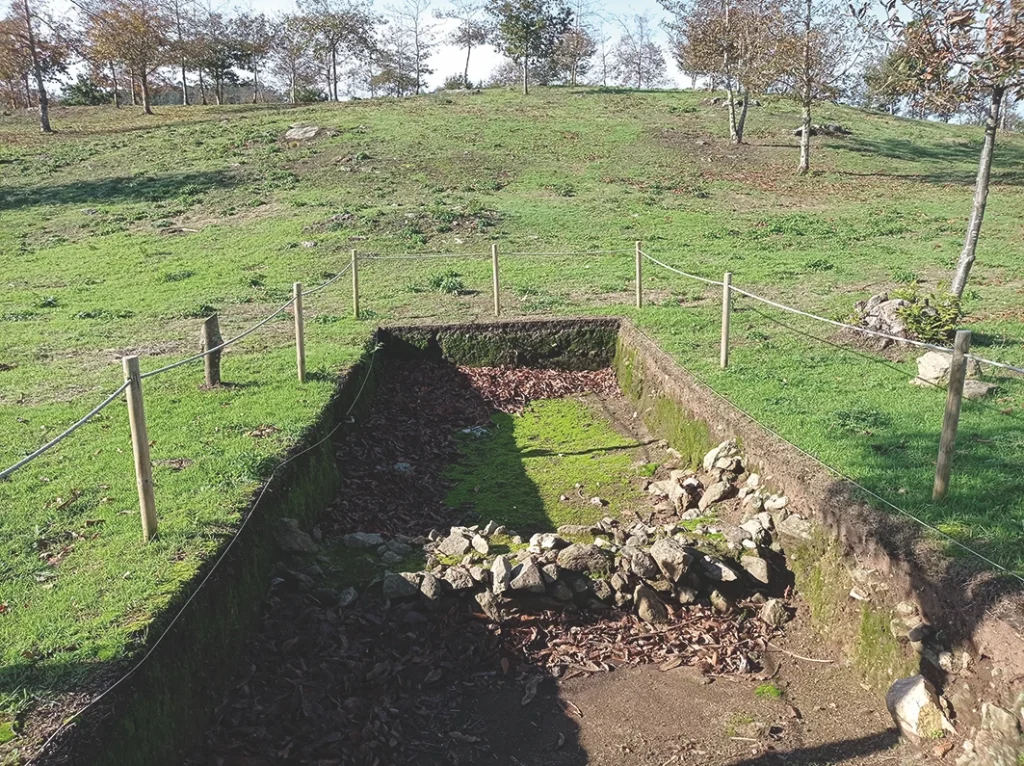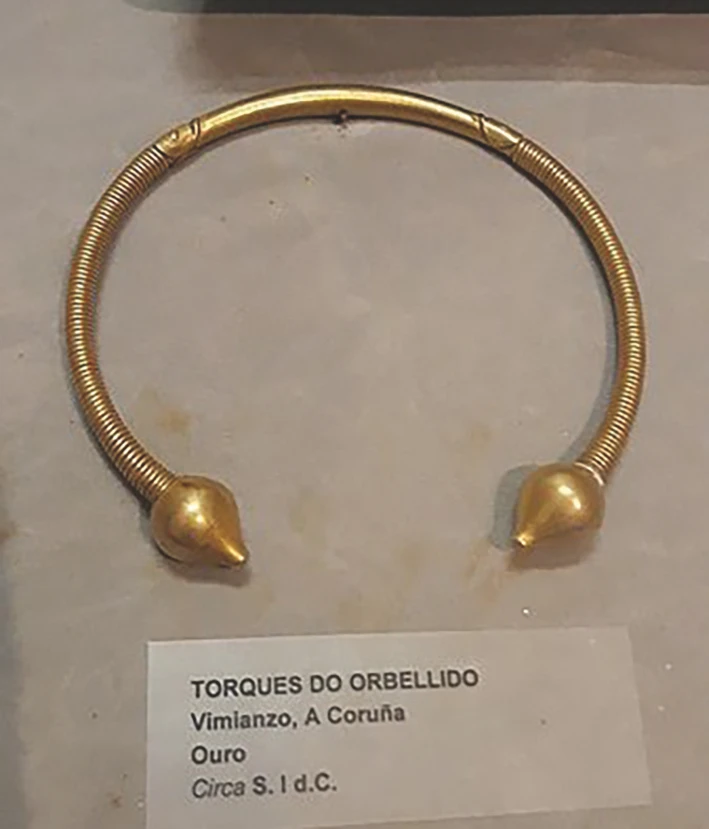This cultural manifestation extended throughout the north western part of the Iberian Peninsula. Its most common characteristic is the fortified settlement, or castro, from the Latin “castrum” (fortress). These settlements set out to protect a territory where its inhabitants had interests in farming, livestock or mining. Most hillforts were built on hills or high places to facilitate defence, but there are others located on open spaces, surrounded by farmland, and in coastal areas, which would have been built to make use of marine resources and to trade with other settlements.
These prehistoric settlements were circular or elliptical in shape, with a surrounding defensive system made up of one, two or three defensive lines alternating with ditches. In many case the inhabitants made use of natural features such sloping terrain and coastal cliffs for defence.
There are many hillforts distributed throughout Costa da Morte. Some can be found on the topmost point of mountains to aid in their defence, such as Monte Aro (Mazaricos), Castro de Xansón (Moraime, Muxía), Monte Croado (Carnés, Vimianzo), Castro de Lume de Suso (Castro, Coristanco) and Coto do Castro (Artes, Carballo). Others can be found on slopes or flatter ground, such as Mintiráns (Caberta, Muxía), As Barreiras (Vimianzo), Nemeño (Ponteceso) and Cances (Carballo). The vast majority were built on hilltops, such as Mallou (Carnota), A Rega (Camariñas), A Croa do Castro (Cerqueda, Malpica), Oca (Coristanco) and Montes Claros (Vilaño, A Laracha). Finally, mention should be made of coastal castros, which made use of cliffs as a natural defence, such as the castro at Punta Galeana (Vilanova, Malpica), Merexo (Ozón, Muxía) or the islet of O Castelo o Herboso (Touriñán, Muxía).

The only castro to be completely excavated in A Costa da Morte is the one at A Cidá (Borneiro, Cabana de Bergantiños), where several excavations were completed throughout the 20th century; the last, directed by Ana Romero Masiá, took place in the 1980s. What is now visible there is 36 circular and rectangular constructions with rounded corners, which occupied three quarters of the space at the top of the settlement. All of them were used for domestic purposes, although not all of them were dwelling places. Besides the space at the top in the eastern part of the castro, where the main entrance of the enclosure was located, there is an area called the “Barrio Extramuros”, where some structures were found, including an oven that was used to forge metals.
Some castros have recently been excavated, such as Mallou, As Barreiras, A Croa do Castro and Montes Claros. Remains of structures and large amounts of pottery were found in some of them.
The period of the Castro culture commenced at the end of the Bronze Age and developed during the Iron Age, to the early days of Romanisation, throughout a period that lasted from the 7th c. BCE to the 1st c. CE.
The first inhabitants of each castro (“castelum“, according to Roman writers) were made up of a community bound by blood ties. Several settlements formed a superior unit called a populus (people), which occupied a territory within a defined border. According to Roman chroniclers, the tribe or populus that lived in Costa da Morte were the nerii in the regions of Fisterra and Soneira and the brigantinos in Bergantiños.
The economy of the castros was based on farming, with different types of cereals (wheat, millet and barley) and some vegetables. The domesticated livestock of the Castro culture included cows, horses, sheep, pigs and poultry, but they also hunted as game was abundant in this period. The coastal settlements also included fish and shellfish in their diet. The bones and shells found in the coastal castros show that this was the case.
Castro peoples were also excellent metal workers. They worked with copper, tin, lead, gold, silver and iron. Bronze objects (fibulae, rings, needles and balls) made of bronze and iron were found in the castro of A Cidá (Borneiro, Cabana de Bergantiños).
The quality of the precious metalwork made by the Castro culture impresses visitors even today for the variety of techniques used in the gold objects that have been found and conserved: torques, diadems, bracelets and necklaces. Torques, such as the one found at Orbellido (Baíñas, Vimianzo) were objects of prestige associated with warriors.

They were also master ceramicists, who commenced shaping clay objects by hand and then with a wheel, making pieces in a wide variety of shapes and decorated with many different plant motifs, which they used to store and transport goods, for domestic use and for rituals or leisure. A large quantity of highly fragmented pottery has been found at the castro of A Cidá. Similar sites where many potsherds have been found in Costa da Morte include Montes Claros, As Barreiras and Mallou.
Local Roman inscriptions indicate that the religious pantheon of the Castro culture was many and varied. Latin writers mention over 200 names of gods, although in some cases the same god could have different names depending on the region.
There were many divinities linked to nature and the astral world. The Castro culture was a warlike society and so a large number of gods were dedicated to war, such as Coso, who appears in many of the inscriptions.
On the other hand, there were also gods and goddesses of fertility who watched over plants, animals and people, and who were prayed to to protect the harvests, livestock and the family. Others were also responsible for protecting the home.
Areas inside the most central and highest points of especially large castros have been identified as places where religious rites may have been practised. The most common rituals were sacrifices and animal offerings to the gods.
Some details of the social life and customs of the Castro culture have been passed down through Roman historians, who considered them to be barbarians because their customs were different, such as drinking water instead of wine and eating bread made from acorns. They were also said to eat while sitting on long benches and that the men grew their hair long like the women.
Written records suggest that women played an important role in farming and in the care and breeding of livestock, while men’s roles were more closely linked to warfare and politics.